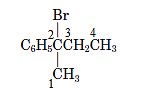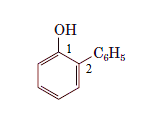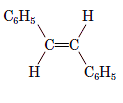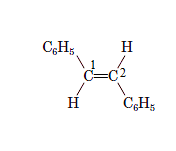
Concept explainers
(a)
Interpretation:The name of the following compound should be determined:

Concept Introduction: International Union of Pure and Applied Chemistry (IUPAC) recommended a nomenclature method used for naming organic chemical compounds.
(a)
Answer to Problem 59P
1-chloro-4-nitrobenzene.
Explanation of Solution
For the given organic compound, the number of substituents present on benzene ring is two and no substituent in the compound imparts special name. So, the numbering is done according to alphabetical order:

The name of the substituent at position 1 is chloro and at position 4 is nitro. So, the name of the compound is 1-chloro-4-nitrobenzene.
(b)
Interpretation: The name of the following compound should be determined:

Concept Introduction: International Union of Pure and Applied Chemistry (IUPAC) recommended a nomenclature method used for naming organic chemical compounds.
(b)
Answer to Problem 59P
2-bromotoluene.
Explanation of Solution
For the given organic compound, the number of substituents present on benzene ring is two and due to presence of methyl group its parent molecule is -toluene. The numbering for rest substituent is done as shown:

The name of the substituent is -bromo and is present at position 2 so, the name of the compound is 2-bromotoluene.
(c)
Interpretation: The name of the following compound should be determined:
Concept Introduction: International Union of Pure and Applied Chemistry (IUPAC) recommended a nomenclature method used for naming organic chemical compounds.
(c)
Answer to Problem 59P
1-chloro-3-phenylpropane.
Explanation of Solution
In
The substituent at position 1 is chloro so, the name of the compound is 1-chloro-3-phenylpropane.
(d)
Interpretation: The name of the following compound should be determined:

Concept Introduction: International Union of Pure and Applied Chemistry (IUPAC) recommended a nomenclature method used for naming organic chemical compounds.
(d)
Answer to Problem 59P
2-bromo-2-phenylbutane.
Explanation of Solution
In the given compound,

The substituent at position 2 is bromo so, the name of the compound is 2-bromo-2-phenylbutane.
(e)
Interpretation: The name of the following compound should be determined:

Concept Introduction: International Union of Pure and Applied Chemistry (IUPAC) recommended a nomenclature method used for naming organic chemical compounds.
(e)
Answer to Problem 59P
2-nitroaniline.
Explanation of Solution
For the given organic compound, the number of substituents present on benzene ring is two and due to presence of

The name of the substituent is -nitro present at position 2 so, the name of the compound is 2-nitroaniline.
(f)
Interpretation: The name of the following compound should be determined:

Concept Introduction: International Union of Pure and Applied Chemistry (IUPAC) recommended a nomenclature method used for naming organic chemical compounds.
(f)
Answer to Problem 59P
2-phenylphenol.
Explanation of Solution
For the given organic compound, the number of substituents present on benzene ring is two and due to presence of hydroxyl group its parent molecule is -phenol. The numbering for the substituent is done as shown:

The name of the substituent is -phenyl present at position 2 so, the name of the compound is 2-phenylphenol.
(g)
Interpretation: The name of the following compound should be determined:

Concept Introduction: International Union of Pure and Applied Chemistry (IUPAC) recommended a nomenclature method used for naming organic chemical compounds.
(g)
Answer to Problem 59P
trans -1,2-diphenylethene.
Explanation of Solution
In the given compound,

The phenyl substituents are present at opposite sides of the double bond so, the name of the compound istrans -1,2-Diphenylethene
(h)
Interpretation: The name of the following compound should be determined:

Concept Introduction: International Union of Pure and Applied Chemistry (IUPAC) recommended a nomenclature method used for naming organic chemical compounds.
(h)
Answer to Problem 59P
2,4-dichlorotoluene.
Explanation of Solution
For the given organic compound, the number of substituents present on benzene ring are three and due to presence of methyl group its parent molecule is -toluene. The numbering for the substituent is done as shown:

The name of the substituent is -chloro present at position 2 and 4 so, the name of the compound is 2,4-dichlorotoluene.
Want to see more full solutions like this?
Chapter 12 Solutions
Introduction To General, Organic, And Biochemistry
- I need help with the followingarrow_forwardFor Raman spectroscopy/imaging, which statement is not true regarding its disadvantages? a) Limited spatial resolution. b) Short integration time. c) A one-dimensional technique. d) Weak signal, only 1 in 108 incident photons is Raman scattered. e) Fluorescence interference.arrow_forwardUsing a cell of known pathlength b = 1.25115 x 10-3 cm, a water absorption spectrum was measured. The band at 1645 cm-1, assigned to the O-H bending, showed an absorbance, A, of 1.40. a) Assuming that water density is 1.00 g/mL, calculate the water molar concentration c (hint: M= mole/L) b) Calculate the molar absorptivity, a, of the 1645 cm-1 band c) The transmitted light, I, can be written as I= Ioexp(-xb), where x is the absorption coefficient (sometimes designated as alpha), Io is the input light, and b is the cell pathlength. Prove that x= (ln10)*x*c. (Please provide a full derivation of the equation for x from the equation for I). d) Calculate x for the 1645 cm-1 bandarrow_forward
- For CARS, which statement is not true regarding its advantages? a) Contrast signal based on vibrational characteristics, no need for fluorescent tagging. b) Stronger signals than spontaneous Raman. c) Suffers from fluorescence interference, because CARS signal is at high frequency. d) Faster, more efficient imaging for real-time analysis. e) Higher resolution than spontaneous Raman microscopy.arrow_forwardDraw the major product of the Claisen condensation reaction between two molecules of this ester. Ignore inorganic byproducts. Incorrect, 5 attempts remaining 1. NaOCH3/CH3OH 2. Acidic workup Select to Draw O Incorrect, 5 attempts remaining The total number of carbons in the parent chain is incorrect. Review the reaction conditions including starting materials and/or intermediate structures and recount the number of carbon atoms in the parent chain of your structure. OKarrow_forwardUsing a cell of known pathlength b = 1.25115 x 10-3 cm, a water absorption spectrum was measured. The band at 1645 cm-1, assigned to the O-H bending, showed an absorbance, A, of 1.40. a) Assuming that water density is 1.00 g/mL, calculate the water molar concentration c (hint: M= mole/L) b) Calculate the molar absorptivity, a, of the 1645 cm-1 band c) The transmitted light, I, can be written as I= Ioexp(-xb), where x is the absorption coefficient (sometimes designated as alpha), Io is the input light, and b is the cell pathlength. Prove that x= (ln10)*x*c d) Calculate x for the 1645 cm-1 bandarrow_forward
 Living By Chemistry: First Edition TextbookChemistryISBN:9781559539418Author:Angelica StacyPublisher:MAC HIGHER
Living By Chemistry: First Edition TextbookChemistryISBN:9781559539418Author:Angelica StacyPublisher:MAC HIGHER Chemistry for Engineering StudentsChemistryISBN:9781337398909Author:Lawrence S. Brown, Tom HolmePublisher:Cengage Learning
Chemistry for Engineering StudentsChemistryISBN:9781337398909Author:Lawrence S. Brown, Tom HolmePublisher:Cengage Learning World of Chemistry, 3rd editionChemistryISBN:9781133109655Author:Steven S. Zumdahl, Susan L. Zumdahl, Donald J. DeCostePublisher:Brooks / Cole / Cengage Learning
World of Chemistry, 3rd editionChemistryISBN:9781133109655Author:Steven S. Zumdahl, Susan L. Zumdahl, Donald J. DeCostePublisher:Brooks / Cole / Cengage Learning Introductory Chemistry: An Active Learning Approa...ChemistryISBN:9781305079250Author:Mark S. Cracolice, Ed PetersPublisher:Cengage Learning
Introductory Chemistry: An Active Learning Approa...ChemistryISBN:9781305079250Author:Mark S. Cracolice, Ed PetersPublisher:Cengage Learning Introductory Chemistry: A FoundationChemistryISBN:9781337399425Author:Steven S. Zumdahl, Donald J. DeCostePublisher:Cengage Learning
Introductory Chemistry: A FoundationChemistryISBN:9781337399425Author:Steven S. Zumdahl, Donald J. DeCostePublisher:Cengage Learning





